Are electric cars an ideal solution for the climate emergency? Text by Aurélien Bigo, Researcher on the energy transition in the transport sector. Translated by Stéphanie de la Sayette
2035 will mark the end of the sale of Internal Combustion Engine (ICE) cars in France and more widely in the European Union, leaving the way for electric cars. The transition is already underway: electric cars represented 13% of car sales in 2022 in France, a figure that is increasing each year.
This policy is mainly driven by climate change. However, it is not uncommon to read or hear that electric cars would be worse for the climate than ICE.
So, what do the studies say? Is going electric better in France? What about in other countries in the world? Which phase(s) of the life cycle of an electric car and a ICE emit the most? What other issues relating to cars in general, electric cars may solve (or not)? How do we ensure a sustainable and virtuous development for electric cars?
Let’s try and untangle this (electric!) debate…
Electric car or Internal Combustion Engine car, which one is better?
Several studies have analysed and compared the GHGs of ICE versus electric cars in France, by taking into account all stages of the lifecycle of a car, from the production of the vehicle to its end of life, including its use and maintenance. We call it: “life cycle analysis” (or LCAs).
The studies found that, in France, emissions are around 2 to 5 times lower for an electric car than for a ICE (petrol or diesel).
The image below summarises the 10 studies compiled for France over the past 10 years
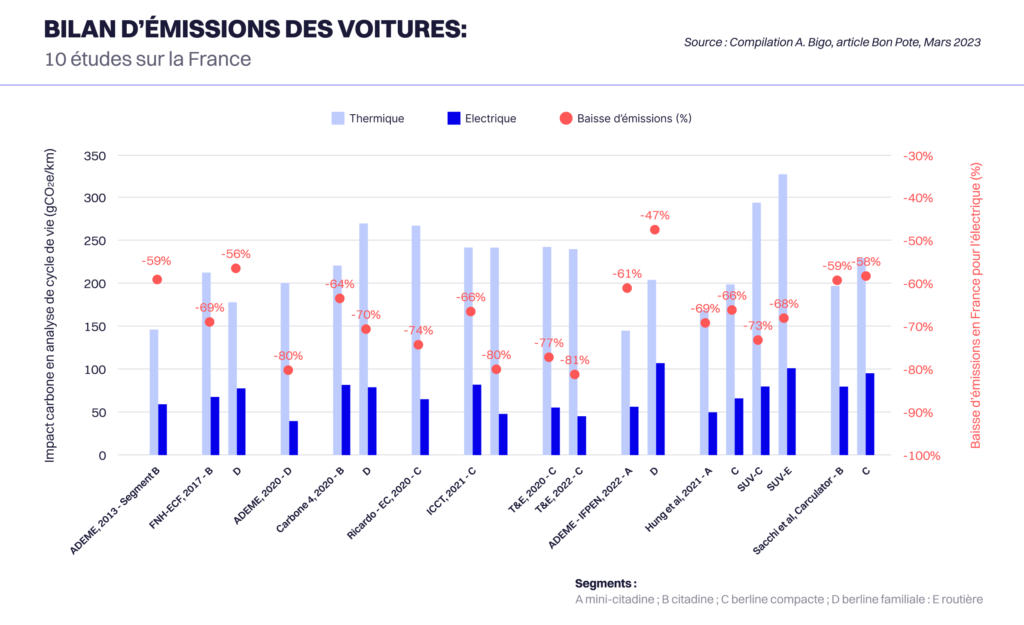
In France, electric cars are better. What about the rest of the world? In Germany, China…?
The energy mix used to recharge EV batteries strongly impacts their carbon footprint. In France, the low-carbon electricity mix thus gives a strong advantage compared to other countries.
The IPCC compilation and many academic studies (here, here or here) show that, in the vast majority of countries in the world, the electric car is already a better choice. For example, in Germany, the decreases of GHG emissions are around -25% to -60% (division by 1.3 to 2.5) depending on the studies.
Only in a few countries, which are largely dependent on coal for their electricity, is the negative impact of electric cars often found to be greater than for ICE, for example in India or Poland, and sometimes in China, according to the analysis (see the document in section 3 for the sources and details).
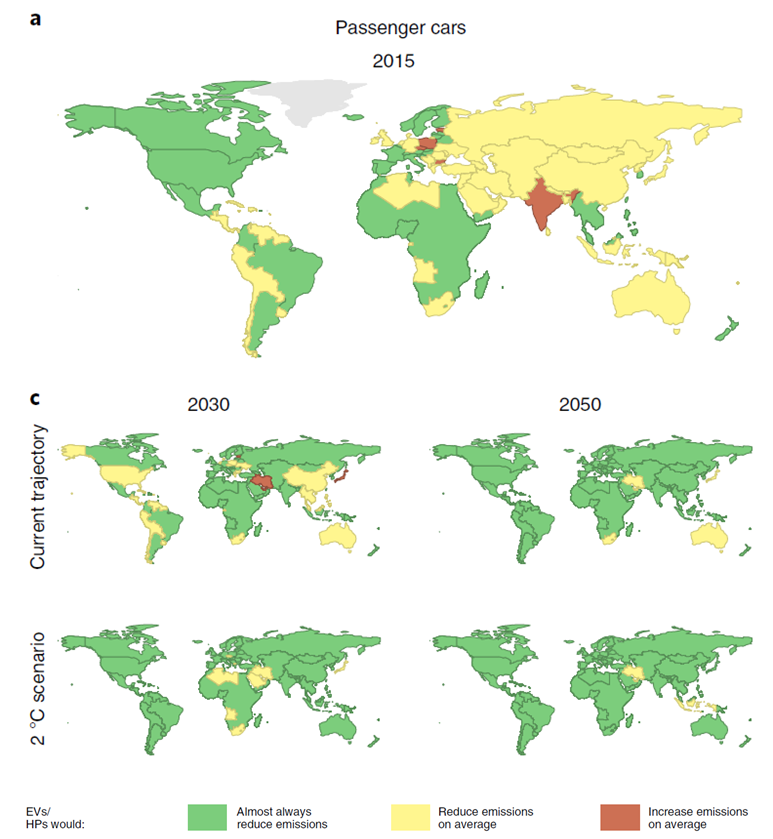
But even in these countries, and due to the gradual decarbonisation of electricity, the electric car will become a better option than ICE in the coming years. Further, at the global level, the International Energy Agency estimates that electric is on average emitting two times less than ICE today. It is still insufficient at this stage to achieve the climate goals, but the benefits are already clear. And the role of electric vehicle will be major in decarbonising transportation in the future.
Indeed, the IPCC indicated in its Third Part of its Sixth Assessment Report: “ Electric vehicles powered by low-carbon electricity offer the main potential for decarbonizing land transport, in life cycle analysis”.
Lifecycle, battery, electricity… why such discrepancies between studies?
Several factors explain the discrepancies between the different studies of the life cycle analysis. They influence the level of emissions of vehicles in absolute terms, but also the differential between ICE and electric (in %).
Among the most significant factors are: the electric mix for the use of EVs, the total mileage of the vehicles over their lifetime, various batteries properties (including: capacity, emissions associated with their production, potential second life), their size, their energy consumption, and whether emissions linked to infrastructures are taken into account. These factors, and the main results of the studies cited above, are summarised in the slides below.
Even for a single factors, different hypothesis may be relevant. It is therefore the order of magnitude is what is important to keep in mind. Nevertheless, despite the diversity of hypothesis of the studies for France, the conclusion is always the same: when it relates to the impact on the climate, an electric car is doing much better than a car that runs on petrol!
Is the production of an electric car emitting more than the production of a Internal Combustion Engine one?
This must be the most debated issue in relation to electric cars.
It is true that the production phase of electric cars is emitting more GHGs. This surplus of emissions is approximately +50% (but varies from approximately +20% to more than a multiplication by 2 according to studies) and is essentially due to the manufacture of the battery.
On the other hand, in France, the emissions resulting from the use of an electric car are easily 15 times lower than for a Internal Combustion Engine car. This is because the final energy consumption for an electric car is about 3 times lower, thanks to a more efficient engine (which would limit the surplus of electricity consumption needed for electric cars to 20% of current consumption, even without energy sobriety). But also because electricity generation in France emits about 5 to 6 times less CO2 per unit of energy than producing and burning petrol.
Emissions are now greater for vehicle production
For electric cars in France, the bulk of emissions comes from the production phase of the vehicle. This is a major difference with Internal Combustion Engine in terms of emissions over their life cycle. For petrol vehicles, more than three-quarters of GHGs are linked to the usage of the vehicle (i.e. the production and combustion of fuels).
It is the opposite for electric cars, where three quarters of the overall impact on climate are due to the production of the vehicle, while the use of the vehicle emits little CO2.
What is true for the impact on the climate is also true for several other environmental impacts of cars and their costs: these are higher for the production (or purchase) of electric vehicles, but lower when it relates to the usage of the vehicle.
To limit these production costs, it is therefore better to focus on lighter vehicles with a smaller battery.
Is an electric SUV worth it?
It depends how you look at it.
The study by Hung et al (2021) gives us 3 findings relating to the climate impact, in France, depending on the type of vehicle, from the mini-car to the large SUV:
- For the 4 types of vehicles assessed, the percentage in reduction in emissions when switching from ICE to electric is similar, nearing -70%;
- On the other hand, with an equivalent engine, over its life cycle, the mini-car will have emissions that are twice as low as the large SUV, hence why light vehicles should be favoured;
- Thus, electrifying a large SUV allows a reduction in emissions twice as large as electrifying a small car, because the reduction percentage is similar, but the large SUV has more impact.
Therefore, the electrification of vehicles makes it possible to reduce the carbon impact regardless of the type of vehicle. And the benefits are all the greater when replacing old, high-emitting ICE vehicles.
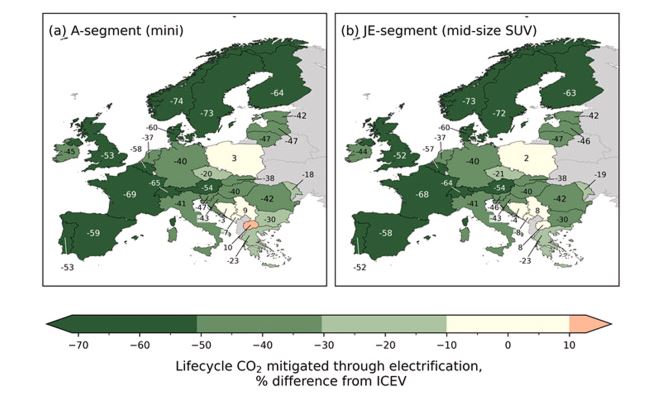
But vehicle electrification alone will not be enough to achieve our climate goals. Its deployment is too slow compared to the short-term reductions needed. The electric car often remains too emitting (especially for the heaviest vehicles). Wasting voltage resources (especially metals used for the battery) can limit the electrification of a higher number of more virtuous vehicles.
It is therefore necessary to combine electrification with a strong transformation of our mobility towards more energy sobriety. Electric SUVs, which are less aerodynamic and often heavier, do not meet this dual requirement.
Do electric cars solve problems relating to vehicles in general?
It depends which sustainability issues we are looking at. Beyond the impact on the climate, cars currently have many other environmental, social and health impacts.
The benefits of electric linked to the phasing out of petrol
By removing the need for petrol for the vehicle usage, the benefits of switching to electric are on several levels. The most significant challenge with regard to climate change is exiting from fossil fuels, along with improving health and quality of life relating to air and noise pollution.
For air pollution, switching to electric means that pollutants from the exhaust of Internal Combustion Engine are eliminated (however there are still emissions of particles beyond the exhaust). It also means that noise pollution relating to the internal combustion of ICE is eliminated, even though the noise of the vehicle’s friction with the air and the road remains, in particular when driving above 50 km/h. The negative impacts are therefore reduced, without however disappearing completely.
The disadvantages of cars in general remain
Transitioning to electric will not have any impact on several other nuisances associated with cars.
First, the space taken by vehicles, whether in traffic or parked, have the consequence of limiting the space that could be used by other modes of transport, or social activities, and it reinforces the artificialisation of soils and “urban heat islands”. Electric cars will not change anything on accident rates either, considering road fatalities in France have not fallen for 10 years.
The same goes for fitness levels, with 95% of the French population too inactive and/or sedentary. A finding that should encourage us to reconnect with more active forms of mobility, such as walking and cycling.
Finally, the problems of unequal access to mobility are unlikely to change. In terms of costs, electric cars are now a little cheaper over the entire lifecycle of the vehicle, but the higher purchase cost limits its distribution. This is all the more the case as manufacturers strategies are geared towards higher-end, larger and more expensive vehicles, on which they make more profit margins.
New constrains on the resources with electric
Finally, it is mainly on the question of resources that electrification poses new sustainability challenges, compared to ICE. It would take more than several articles on the subject, but in a nutshell, we already know that Internal Combustion Engine, and the automotive system as a whole, are highly resource-intensive.
Electric cars require more precious metals for batteries, with its own issues in terms of availability, pollution, social and/or geopolitical issues associated with the extraction of these resources. But the oil needed for Internal Combustion Engine is not exempt of similar issues.
NEWSLETTER
Chaque vendredi, recevez un condensé de la semaine, des infographies, nos recos culturelles et des exclusivités.
ALERTE
Une alerte dans votre boite mail, pour être mis au courant dès qu’un nouvel article est en ligne sur Bon Pote
Can we keep the same attitudes towards mobility in the future?
Electric cars only reduce parts of the problems related to cars without solving them entirely. If we want to respond appropriately to the various transition challenges, we need to reduce our dependence on cars as a means of transportation.
It will not be enough to transition from 38 million ICE private cars to 38 million (or more) electric private cars, whilst keeping the same habits with regards to usage.
Electric cars emit more than walking, cycling, the train (with the exception of diesel train when not at full capacity) and most of road public transport (depending on the number of passengers). The latter are also likely to evolve towards lower emissions in the future.

How to ensure a virtuous deployment of electric cars?
The environmental and financial costs of electric cars are high during the production phase. This means that it will be necessary to ensure a virtuous deployment of electricity by:
- Limiting the production of new vehicles: for this, we must offer alternatives to the use of individual car (walking, cycling, train, bus, etc.) and promote car-free lifestyles to support reduction/elimination of number of cars owned by individual households;
- Manufacture vehicles with as light, aerodynamic and with as little energy requirement as possible, with reasonable battery capacities and autonomy calibrated on daily journeys, rather than on the few long-distance journeys made throughout the year;
- Extend the lifecycle and the mileage: with high impacts and costs during production, it would be best to make the vehicles the most profitable, by using them extensively, in particular by sharing them more, and by extending their lifecycle as much as possible.
In summary, the share of electricity used by motorised vehicles needs to be the highest possible, whilst limiting the number of batteries sold.
We will need to engage all levers of the energy transition, both technological and from an energy sobriety point of view, including: reduction of mileage, modal shift towards active alternative modes of mobility and public transport, better sharing of vehicles, speed limit and vehicle weight, electrification, etc.
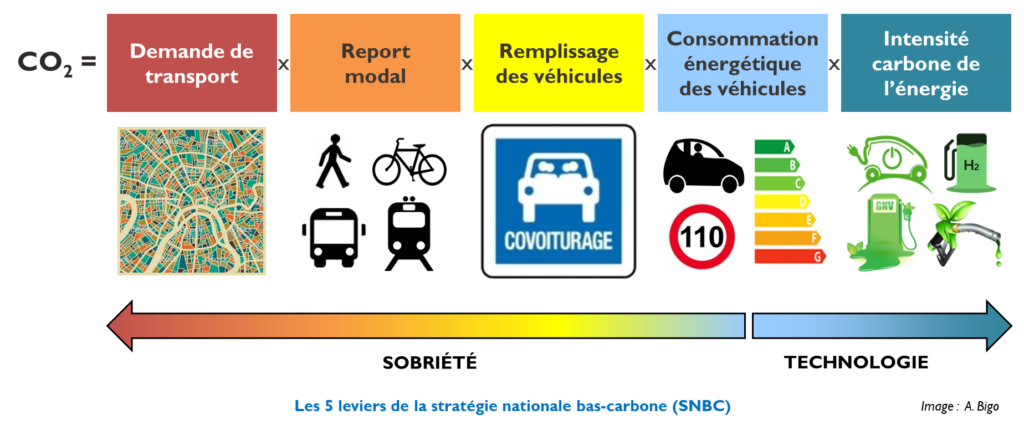
Is it better to keep my old Internal Combustion Engine or to change it for an electric car?
There is no straightforward or right answer.
It strongly depends on several factors, including the vehicle and its usage, the future of Internal Combustion Engine (breakdown or resale), the impacts considered (CO2 emissions, resources, pollution, etc.) and the length of time over which these impacts are measured. Going electric means additional emissions, consumption of resources and pollution in the short term (during the production phase), but with a view to gradually reduce some of it over the life cycle of the vehicle in the long term.
If you are looking to change vehicle, the only time where it does not make sense from a climate perspective to switch to electric, is if you very rarely use the car. This is because there is more impact during the production phase, for little gain during the lifecycle of the vehicle, if not driven much. The best thing to do is to try to live without a car and use alternative solutions as much as possible (walking, cycling, train, bus, carpooling, etc.), and occasionally rent a vehicle (electric, ideally!) for journeys that require a car.
In all the other cases, and if you have the possibility of installing a charging station at home or have one nearby (yes, there is still a lot to do when it comes to the issue of charging station!), it is better to go electric.
If you have a city car that has been manufactured in large quantities (like a Twingo), the ideal is to “retrofit” your ICE. This consists of transforming a Internal Combustion Engine into an electric one, which is virtuous from the point of view of resources usage. However, the offer to do so is not very developed at this stage, which means having to buy new to renew the park.
Price, range, size… what type of electric vehicle should I choose?
There is no single answer here, it depends on your usage and needs.
If you have no other choice than using a car, the most virtuous option is to choose an electric vehicle calibrated for daily use. Until now, the tendency was to do the opposite and calibrate the purchase of a car on the few exceptional journeys we take throughout the year (such as going on holidays).
For example, buying a 5-Seater car, easily exceeding 1.5 tonnes, traveling at 180 km/h, with an electric autonomy of several hundred kilometers… when it ends up being used for trips with 1 or 2 people on board, often at a maximum speed of 80 km/h, and less than 80 km from home for 98.8% of its usage. Even when a two-person household has two cars, usually those cars are 5-Seater.
Oversizing is the tendency for a large number of vehicles! It means a larger vehicle size with larger batteries. This is costly both for the environment and for the wallet, often making electric cars unaffordable: every time the weight of the vehicle increases by 100 kg, its purchase price increases by 3,000 Euros. For example, the Dacia Spring weighs around 1 ton and sells for around 20,000 Euros (excluding bonuses). For cars of 2 tons and more, it increases to 50,000 Euros or more.
Turning to lighter vehicles
Sign of a growing interest for inexpensive electric models, the lightest electric cars on the market are among the best sellers of 2022 in France. The Peugeot e-208 city car is in the lead, ahead of the Dacia Spring, and the electric versions of the Fiat 500 and the Renault Twingo are in 5th and 6th position. Still, the most energy efficient vehicles are rarely produced or assembled in France (except for the Renault Megane e-Tech or the Renault Zoé). Aligning environmental and societal issues with those of the local economy and jobs must be a priority for the industrial policy in France.
Beyond these electric city cars, lighter electric cars are even more virtuous if they develop well as a replacement for the car. For example, electric cars weighing less than 500 kg such as the Renault Twizy (or the Mobilize Duo which will replace it) which has a version limited to 80 km/h, the Microlino which goes up to 90 km/h or the Citroën Ami which is limited to 45 km/h.
These light electrical cars are the intermediate vehicles between a bicycle and a car. They are much more energy efficient than current cars and yet can respond to several daily usage (we will come back to this).
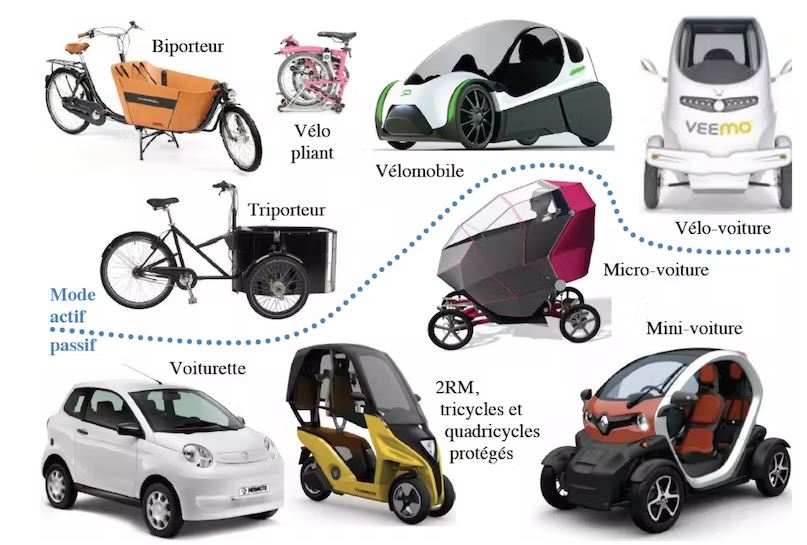
Our attitudes towards driving cars must change
For long distance and when the autonomy of electric cars is insufficient, alternative modes of transportation like the train, coach, carpooling or car rental, are by far the best option. These alternatives must be strongly encouraged, and public authorities must develop the offers to enable as many people as possible to limit themselves to drive lighter electric vehicles with a reasonable battery capacity and range.
Finally, we also need to limit the negative impacts of electric cars on the power grid and avoid using fossil fuels during peak times (in winter in particular). For this, it is important to recharge the vehicle battery during off-peak hours. This can be facilitated by a smart (or remote) charging control system, to best adapt to the pressure on the power grid.
What about hydrogen? Hybrid? Biofuels?
Sticking to petrol vehicles is incompatible with our climate goals. If electric is favoured in the future to replace it, it is because the other alternatives offered are not up to the challenges.
Hydrogen across the world is still produced at more than 99% from fossil fuels, which means its decarbonisation will be slow, and the energy efficiency from hydrogen use is much worse than that of battery-powered electricity, its cost is much more important, and the charging grid will forever remain less developed than for electric. This means that hydrogen will not be a mass solution for cars (more information in this article). By extension, this conclusion is also valid for synthetic fuels (or “e-fuels”), produced from hydrogen, and whose overall efficiency is even lower.
The current development of hybrid and rechargeable hybrid is far from being virtuous, with heavy and very expensive vehicles, and they still rely too much on fossil fuels to be an interesting long-term alternative to get out of petrol (more info in this article).
Biofuels and biogas, a good option?
Finally, biofuels or biogas are mostly available in insufficient quantities. If we wanted to replace all the petrol consumed in transportation with first-generation biofuels, we would have to use all the land cultivated in France for their production (almost 50 Mtep consumed, 3-4 tep/ha and 15.6 Mha cultivated).
Further, if we want to avoid competition with usage for food, we must switch to 2nd generation biofuels, based on waste or non-recovered biomass, which means resources are even more limited, and must be re-directed towards the sectors or modes of transportation that have the fewest alternatives available.
Conclusion: what to take away from all of this?
First of all, the electrification of cars is crucial for the climate. All the scenarios in France or in the world agree on this. Intentionally or not, to oppose electricity is to oppose the achievement of our climate goals and to make us dependent on oil for longer.
However, electrification is far from being a perfect and magic solution. It will not be enough to solve the climate challenge posed by transportation or more generally the problems relating to cars. Moreover, many of the criticisms about electric vehicles (it consumes too many resources, is too polluting, too expensive, makes us dependent on other countries, etc.) are true of the Internal Combustion Engine.
It is therefore the issue of choosing an individual car for our mobility, and the type of vehicles and usage we make of it, that we need to focus on changing, if we want to move towards more sustainable mobility.
However, this aspect of energy sobriety is sorely lacking in current transportation policies, which urgently need to change, including: reducing the weight of vehicles, limiting speed at 110 km/h, moderating distances and air traffic, developing cycling, rail and public transport, carpooling…
If we had to remember one message: the future of the car will certainly be electric, but the individual car should not be the future of our mobility.
Thanks
The author Aurélien Bigo would like to thank the following persons for the exchanges on the subject and/or for the proofreading:
- Rodolphe Meyer (from the Le Réveilleur channel, author of 2 videos on the subject here and there)
- Romain Sacchi (lead author of the Sacchi et al 2022 study, and co-designer of the Carculator simulation tool; twitter)
- Thomas Gibon (PhD in industrial ecology and designer of the Climobil tool).














One Response
One other item to add to your excellent list. The economic reliance on building cars for the countries GDP, the companies which make money on financing vehicles, the employment ramifications. These will get sorted out after the Great Dystopia to Star Trek economy transition, but we should be thinking of them now.